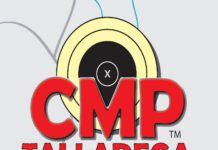One of the major reasons hunters choose a 20 gauge over a 12 gauge is the former’s smaller frame, weight, and recoil. Though they may already own a 12, many field sportsmen wind up reaching for their 20s because the smaller gun is just easier to handle, and there are just a few hunting situations—layback goose hunting and spring turkey hunting, to name two—in which the bigger payload might make a difference.
One 3-inch-chamber 20 gauge we recently tested was the Mossberg SA-20 No. 75771, $496. The Mossberg is a new-for-2008 line for that company, so the SA-20 designation names just a single chambering, as you might expect. However, comparable guns in the 930 autoloader line, which are chambered only for 12 gauge, weigh 7.75 pounds to the SA-20’s feathery 6.0 pounds.
The company’s initial-release copy for this gun is actually pretty accurate: “Introducing the new SA-20 Semi-Automatic 20 Gauge Shotgun by Mossberg International-perfectly balanced, fast handling, lightweight and just as important, easy on your wallet.”
This gas-operated shotgun is available with a standard 14-inch length of pull synthetic stock and forearm, while the SA-20 Bantam features a shortened 13-inch LOP for younger or smaller shooters. Barrel lengths include 26 and 28 inches for the SA-20 and 24 inches for the Bantam. All have ventilated ribs. Our gun measured 48.5 inches in length and weighed 6.0 pounds. It handles 20-gauge 2.75-inch and 3-inch factory loaded shotshells and has a five-round capacity of the shorter shotshells. It comes with the company’s Sport Set of five chokes and a wrench in a small plastic case, a free gun lock, and a one-year limited warranty. All the metal surfaces are matte blue on top of synthetic black stocks. The gun was supposed to come with three drop spacers and one spacer for cast, but those items weren’t included in our sample. C’est la guerre.
The gun is made by Armsan (www.armsan.com) in Turkey, a collaboration of Khanshotguns Co. and ATA Arms. It strongly resembles the A620S by Armsan and the Cy Synthethic by ATA Arms.
Like on the Browning, the gas system vents excess gases to aid in recoil reduction and helps eliminate stress on the operating components. Notable to us was that while shooting this 6-pound gun, we didn’t notice any more recoil with it than the other, heavier guns. Also, it pointed very fast, our team said, and even though we weren’t able to adjust it with the non-included LOP and cast spacers, it fit most of our shooters well out of the box. The trigger-pull weight was a lowest-of-the-test 5.0 pounds, and the rounded trigger itself was comfortable on the finger. The top of the receiver offered a better sight plane than did the Browning, our team said, and was on par with the Remington.
The stock dimensions were comfortable for most of our shooters, including Lefty, since there was no cast in the stock. The wrist, 1.20 inches thick, felt trim in the hand-about the same as the 11-87 and less than the Silver’s 1.3-inch thickness. Moreover, the pistol grip had a forward flip that increased the sensation of control of the gun. On the SA-20, the distance from the middle of the trigger to the forward point of the pistol grip was 4.0 inches to 4.25 inches on the Silver and 4.4 inches on the 11-87. It was probably the most noticeable single handling characteristic separating the guns.
But for all these positives, there were some things on the gun our testers didn’t like. Like the others, it wasn’t drilled and tapped for scope mounting, and this gun lacked sling-swivel studs. For a hunting shotgun, the former item is a big plus, since getting it done well aftermarket is a hassle. Not having studs is a big oversight for a working gun, we feel. Yes, we could buy a loop sling for $10 or we could cut strips out of old towels, for that matter. We prefer being able to affix a proper sling.
A bigger problem, our team said, was the SA-20’s loading sequence. After the shooter loads one in the chamber, he has to press the bolt-release button to release the elevator so another round slides into the tube. Other shotguns have a similar sequence, but in this test, having to use two hands on the receiver to load was a big disadvantage, since the 11-87 released with the touch of a button on the elevator, and the Silver required no secondary release at all. Also, on our sample, the bolt-release button was stiff, and younger shooters, for whom this gun would otherwise be a great fit, had trouble with the button.





























